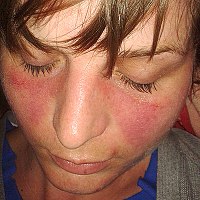
Photo from wikipedia
To-the-Editor: I read with interest the excellent article by Borucki and Werth on drug-induced cutaneous lupus erythematosus [1]. Cutaneous lupus erythematosus includes subacute cutaneous lupus erythematosus and chronic cutaneous lupus… Click to show full abstract
To-the-Editor: I read with interest the excellent article by Borucki and Werth on drug-induced cutaneous lupus erythematosus [1]. Cutaneous lupus erythematosus includes subacute cutaneous lupus erythematosus and chronic cutaneous lupus erythematosus; the latter has also been referred to as discoid lupus erythematosus. Drug-induced cutaneous lupus erythematosus includes not only subacute cutaneous lupus erythematosus, but also – albeit less common – drug induced chronic cutaneous lupus erythematosus [1,2]. The authors performed a superlative review of the literature and provided a comprehensive table that summarized the medications that have been implicated in the development of drug-induced subacute cutaneous lupus erythematosus. In addition, they designated five of those agents that have also been reported to induce both subacute cutaneous lupus erythematosus and chronic cutaneous lupus erythematosus: adalimumab, allopurinol, capecitabine, doxorubicin and lansoprazole [1]. I recently described a 65-year-old woman with breast cancer who developed 5-fluorouracil-induced chronic cutaneous lupus erythematosus when she was receiving six monthly cycles of cyclophosphamide (orally for the first 14 days) and intravenous methotrexate and 5-fluorouracil on days one and eight of each cycle. Erythematous papules and scaling plaques appeared on her face 21 days after starting therapy. The lesions flared during each of the next five chemotherapy cycles [3]. Her antinuclear antibody titer was elevated; however, antibodies to Sjogren syndrome A (Ro) and to Sjogren syndrome B (La) were absent. Within 17 weeks after chemotherapy was discontinued, her skin lesions completely resolved and her antinuclear antibody titer significantly decreased. She received adjuvant radiotherapy followed by daily anastrozole. At fouryear follow-up, there had been no recurrence of the breast cancer or the 5-fluorouracil-induced chronic cutaneous lupus erythematosus facial lesions [3]. Fluorouracil agents (capecitabine, 5-fluorouracil, tegafur and tegafur/uracil) have been associated with both druginduced subacute cutaneous lupus erythematosus [4–6] and chronic cutaneous lupus erythematosus [3,7,8]. Indeed, druginduced chronic cutaneous lupus erythematosus has been reported in 19 oncology patients. Tegafur (ten patients) [8] and tegafur/uracil (six patients) [8] were the causative agents for 84% of the patients; less frequently, either 5-fluorouracil (two patients) [3,8] or capecitabine (one patient) [7] resulted in drug-induced chronic cutaneous lupus erythematosus. Drug-induced subacute cutaneous lupus erythematosus caused by fluorouracil agents, similar to subacute cutaneous lupus erythematosus induced by other drugs, is characterized by the presence of antibody to Sjogren syndrome A [4–6]. In contrast, this antibody was absent in patients with fluorouracil agent-induced chronic cutaneous lupus erythematosus [3,7,8]. The antinuclear antibody was positive in 71% (12 of 17) of the patients with fluorouracil agent-induced chronic cutaneous lupus erythematosus [3,7,8]; after the drug was discontinued, the chronic cutaneous lupus erythematosus skin lesions resolved and the antinuclear antibody titer decreased [3,8]. In summary, medications associated with drug-induced cutaneous lupus erythematosus continue to increase. Indeed, most of the drugs are implicated in the development of subacute cutaneous lupus erythematosus. However, several fluorouracil agents – not only capecitabine, but also 5-fluorouracil, tegafur and tegafur/uracil – can induce chronic cutaneous lupus erythematosus and therefore can be acknowledged in the ‘CCLE also reported?’ column in Table 2 of Borucki and Werth’s article [1].
Journal Title: Expert Review of Clinical Pharmacology
Year Published: 2020
Link to full text (if available)
Share on Social Media: Sign Up to like & get
recommendations!